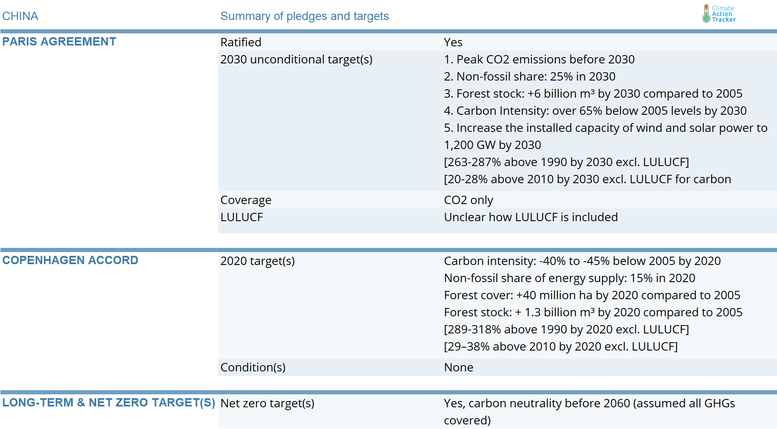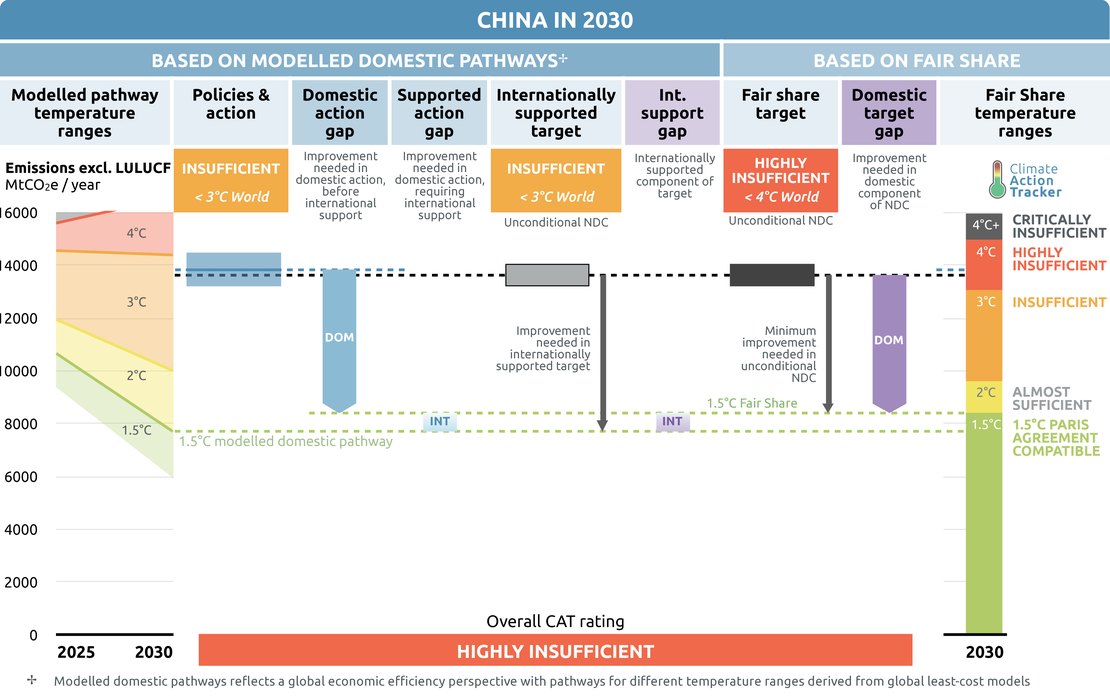Targets
Paris Agreement targets
NDC description
As of the time of this assessment (July 2021), China has yet to officially submit a revised NDC to the UNFCCC although President Xi Jinping announced proposed updates to China’s NDC targets at the UN’s Climate Ambition Summit in December 2020 (CGTN, 2021). The proposed NDC update strengthened and expanded previous 2030 NDC targets and added a fifth new target. The CAT rates China’s proposed NDC targets as “Highly Insufficient”.
While the NDC update is an improvement from its first NDC, it would only lead to a small increase in ambition compared to current policies, meaning China is within range to achieve the new targets without a substantial increase in implementing mitigation policy. According to our analysis, achieving China’s most binding NDC targets (peaking and non-fossil share) would lead to emission levels of 13.2 to 14.0 GtCO2e (in AR4 excl. LULUCF) in 2030 (20% to 28% above 2010 levels), which could be achieved within its current policy projections (13.2 to 14.5 GtCO2e in 2030, equivalent to 20% to 32% above 2010 levels).
China’s proposed updates to its NDC targets are:
- Peaking carbon dioxide emissions “before 2030”, (up from “around 2030 and making efforts to peak earlier”).
- Lower carbon intensity by “over 65%” in 2030 compared to 2005 levels, (up from “by 60- 65%”).
- Share of non-fossil fuels in primary energy consumption to “around 25%” in 2030, (up from “around 20%”).
- Increase forest stock volume by around 6 billion cubic metres in 2030, (previously 4.5 billion cubic metres).
- Increase the installed capacity of wind and solar power to a total of 1,200 GW by 2030.
Among measures to implement enhanced actions on climate change, China also listed the following elements in its existing NDC:
- Proposed reductions in the production of HCFC22 (35% below 2010 levels by 2020 and 67.5% by 2025) and “controlling” HFC23 production by 2020.
China’s existing and proposed NDCs only covers CO2 gases, thus omitting significant emissions from agriculture and industry.
Under China’s most binding peaking and non-fossil share NDC targets, the country’s emission levels would reach between 13.2 to 14.0 GtCO2e in 2030. The lowered NDC emissions range is due to both our quantification of China’s proposed NDC targets (rather than existing), as well as positive energy sector policy developments. As satisfying the proposed NDC commitments is now likelier to result in lower emission levels than our current policies projections (13.2 to 14.5 GtCO2e), we use the upper bound of the NDC commitment range for our NDC rating and global aggregation. In previous years, we used the median of China’s NDC range for both.
Comparing China’s expected emission levels from its NDC commitments to global least cost modelled domestic pathways downscaled to the country level, the CAT rates China’s domestic target in 2030 as “Insufficient”. Even if China submitted its draft NDC update, which only resembles a minor improvement in its emissions trajectory, we would still rate its domestic target as “Insufficient”. The “Insufficient” rating indicates that China’s domestic target in 2030 needs substantial improvements in ambition to be consistent with the Paris Agreement’s 1.5°C temperature limit. If all countries were to follow China’s approach, warming would reach over 2°C and up to 3°C. This rating takes into account that a fraction of China's domestic target consistent with the Paris Agreement 1.5 degree limit would need international support.
China’s emission levels under its NDC commitments are substantially higher than what would be deemed Paris compatible compared to our “fair share” approach, resulting in our rating of “Highly Insufficient”.
The “Highly insufficient” rating indicates that China’s fair share target in 2030 lead to rising, rather than falling, emissions and is not in line with any interpretation of a fair approach to meeting the Paris Agreement’s 1.5°C limit. We base our rating on China’s NDC commitment to peak CO2 and achieve 25% non-fossil fuels in its primary energy mix by 2030, along with other major implemented policies. If all countries were to follow China’s approach, warming could reach over 3°C and up to 4°C.
Were we to base the NDC rating on the carbon intensity target only, it would also be “Highly insufficient,” but the absolute emissions level of this element of the NDC is highly uncertain as it depends on GDP growth.
This rating takes into account that China has effectively submitted an unconditional NDC target but has not indicated a level of emissions that would be achieved with international support (a conditional NDC target). In any event, the present level of unconditional commitment falls substantially short of the commitment that would be consistent with China's fair share contribution to meeting the Paris Agreement's goals.
Whether China should or should not receive some climate finance from abroad to reduce its emissions is a matter of debate. Our methods do not provide a clear answer to this question, although on balance the CAT methodology shows that China needing small but important international support is consistent with the wide range of literature on fair share contributions to meeting the Paris Agreement's goals (the figure above shows it to receive a small contribution). In any case, the NDC target achieved with own resources would need to be increased significantly to be in line with the 1.5°C limit.
Further information on how the CAT rates countries (against modelled pathways and fair share) can be found here.
Last NDC update
As of the time of this assessment (July 2021), China has yet to officially submit a revised NDC to the UNFCCC, although President Xi Jinping announced the draft new NDC at the UN’s Climate Ambition Summit in December 2020 (CGTN, 2021). As we stated in our Climate Target Update Tracker analysis at the time, the updated NDC targets are slightly more ambitious than the current NDC but can feasibly be achieved with current policies. We quantify China’s proposed NDC targets, rather than existing NDC, in our assessment.

Net zero and other long-term target(s)
We evaluate the net-zero target as: Target information incomplete.
China’s President Xi Jinping first announced his country’s commitment to reach “carbon neutrality before 2060” in a declaration at the UN General Assembly in September 2020 (FMPRC, 2020). The target is not yet enshrined in law nor in any policy document. If China’s net zero target were to cover all GHG emissions, its long-term strategy could be within range of mid-century Paris Agreement compatible emissions levels, although compatibility also depends on the shape of the pathway (Yvonne Deng et al., 2020). While Xie Zhenhua, China’s climate envoy, suggests the target covers non-CO2 GHGs, it is not yet clear whether this is the government-wide interpretation (Baptista, 2021). As most of the target information remains unclear and incomplete, the CAT is currently unable to comprehensively assess China’s net zero target. For a full analysis, click here.
China has not yet officially submitted a long-term strategy (LTS) to the UNFCCC although the Ministry of Ecology and Environment noted the document has been in the process of elaboration since 2019 (Farand, 2019; UN Secretary-General, 2019). In a US-China bilateral summit in 2021, both countries recommitted their intention to submit an LTS this year (Ministry of Ecology and Environment of China, 2021; US DOS, 2021).
2020 Pledge
China’s 2020 pledge consists of the following elements:
- Overall reduction of CO2 emissions per unit of GDP by 40–45% below 2005 levels by 2020;
- Increase the share of non-fossil fuels in primary energy consumption to around 15% by 2020;
- Increase forest coverage by 40 million hectares and forest stock volume by 1.3 billion cubic metres by 2020 from 2005 levels.
The CAT’s calculations show that the 2020 carbon intensity target represents a range of 14.1 to 15.2 GtCO2e in 2020, which was overachieved according to our 2020 emissions estimate (13.8 GtCO2e). This is due primarily to enhanced climate policy, as China’s rapid recovery from the COVID-19 pandemic led to increased emissions. For details of how we quantify China’s NDC targets, please see the assumptions section.
Summary table

Further analysis
Latest publications
Stay informed
Subscribe to our newsletter





